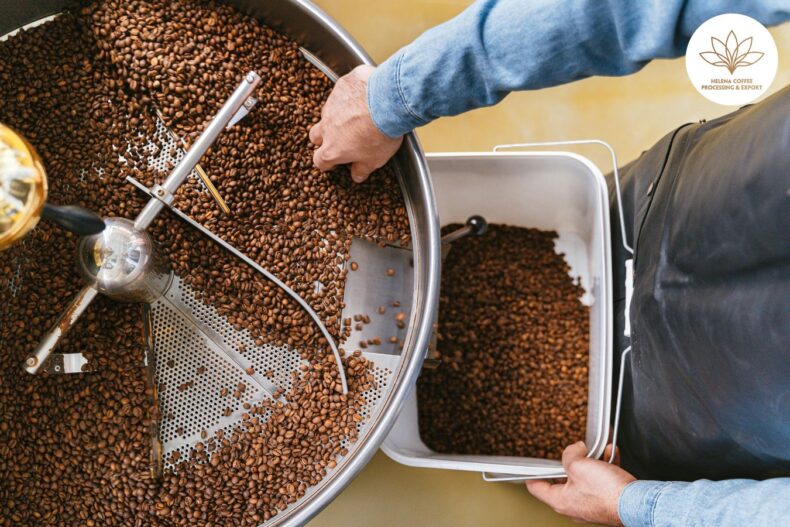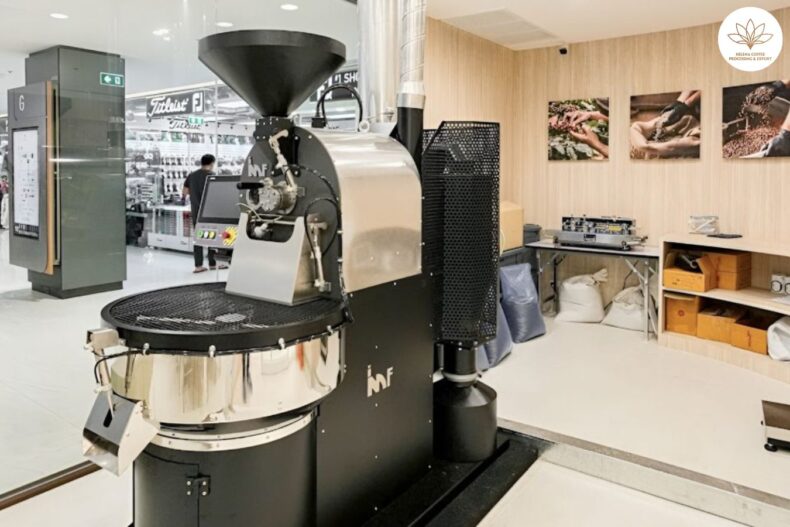
In coffee roasting: The current dynamics of the coffee value chain typically result in coffee growers primarily earning income from the sale of green beans. However, the majority of value is added in consuming countries, where coffee is roasted, packaged, and sold.
Consequently, only a small percentage, usually between 5-10%, of the profits generated make their way back to the producers. This has led to a growing interest among coffee growers in roasting at the source. However, this endeavor requires substantial knowledge, training, resources, and access to markets, among other crucial factors.
To understand what producers need to consider in order to successfully position themselves in the coffee roasting sector, I spoke with two experts. Continue reading to discover their insights.
What drives producers to solely concentrate on green coffee?
Why do producers limit their focus to green coffee? One of the primary reasons is the substantial investment required in machinery, training, technology, and facilities for coffee roasting. Additionally, the roasting market has traditionally been dominated by large multinational corporations with significant capital, making competition exceedingly challenging for smaller producers.
According to Rodrigo Jaeger Ricalde, a commercial engineer and CCO of Blackdrop Coffee in Chile, entering this realm is primarily feasible for farms with advanced development, reputation, and robust capital structures. However, for the average coffee farmer, hurdles such as limited access to financing and education make it a daunting task.
Despite these obstacles, there has been a notable increase in the market for roasting at origin over the past decade. In coffee roasting: This model offers substantial benefits, such as enhancing the local economic impact. While the associated challenges are undeniable, overcoming them can lead to the consolidation and strengthening of a producer’s business model.
To embark on this journey in the value chain, Rodrigo suggests a systematic approach: “Moving from the micro to the macro, you need a roaster, technical expertise, and a clear vision outlined in your business plan. In coffee roasting: This involves evaluating all potential opportunities for roasting coffee locally, regionally, nationally, or even internationally. It’s crucial to understand what you intend to do with your roasted coffee and which sectors you aim to supply, whether it be cafes, specialty stores, restaurants, or providing roasting services to neighboring farms.”
Enhancing profitability, benefits, and empowerment in coffee cultivation
Economic advancement stands as a cornerstone for both coffee producers and their local communities. In coffee roasting: Venturing into the realm of roasting one’s own coffee can open doors to fresh job opportunities, thereby bolstering the influx of capital for reinvestment in coffee cultivation and enhancing overall quality of life. According to Rodrigo, the practice of roasting coffee at its source introduces a potent synergy that yields multifaceted benefits.
“Having control over both the green coffee and the roastery enables me to market it in its raw form or through my own roasting and branding,” he asserts. “Moreover, it facilitates a deeper understanding of the roasting process and the creation of blends utilizing the diverse varieties cultivated on the farm. Ultimately, it’s a mutually beneficial arrangement.”
Miranda Edelmann Toriello, a Q grader, producer, and CEO of Postales Café in Mexico, further elaborates that roasting at origin streamlines the intermediary chain, leading to more controlled and enhanced profits from coffee sales. In coffee roasting: This streamlined approach fosters and fortifies the local economy, benefiting the entire coffee community.
Additionally, Miranda highlights that by adding value through roasting, producers gain firsthand insight into the end product destined for consumers. In coffee roasting: This heightened understanding fuels motivation to experiment with novel techniques and practices aimed at elevating product quality. Indeed, when coffee farmers wield greater control and empowerment over their coffee, in coffee roasting: they can meticulously analyze its quality and discern how specific flavor profiles translate into the final cup.
Rodrigo emphasizes another pivotal benefit for producers: “A thorough comprehension of roasting empowers the producer to engage in meaningful discussions with potential buyers regarding optimal roasting techniques and achievable flavor profiles tailored to their unique coffee offerings.”
Guidelines for entering and establishing presence in the roasting market
Miranda underscores the importance of tailored strategies based on the specific circumstances of the producing country and individual farms:
- Familiarize yourself with government regulations pertaining to infrastructure and technology.
- Acquire financial literacy, undergo quality training, and standardize your brand.
- Access comprehensive technical knowledge of the roasting process.
- Utilize farm-generated data to exert greater control over the sale of the final product.
- Implement changes in financial dynamics to ensure a steady flow of income throughout the year.
- Diversify your client base in coffee roasting: (exporters, restaurants, cafes, retailers, etc.) to leverage control over both green and roasted products.
In addition, Rodrigo emphasizes the following prerequisites for coffee growers:
- Make investments in a roaster, allocate space, and procure necessary tools for the farm or local coffee community.
- Prioritize investment in education to enhance expertise.
- Establish a steady coffee flow by developing statistics and projections within an annual sales model to anticipate potential income.
- Formulate a brand identity and marketing strategy to augment market value and consumer visibility.
- Gain a comprehensive understanding of your capabilities as a coffee grower and delineate clear market objectives.
- Develop a structured approach to categorize coffee qualities, such as exporting the most exceptional microlots while roasting the remainder for regional consumption.
What to avoid when venturing into this stage
Both Miranda and Rodrigo concur on the critical aspects to steer clear of:
- Engaging without a sound economic model, which involves overlooking the expenses associated with roasting, including equipment, facilities, energy consumption, packaging, logistics, and ongoing maintenance.
- Neglecting to treat the farm as a business entity, which diminishes the potential value of the product.
- Disregarding the varying levels of development in coffee, whether commercial or specialty, as each segment caters to distinct markets and attracts different capital flows.
- Attempting to go solo; instead, it’s advisable to join coffee organizations where knowledge sharing, assistance, and market insights are available in a more structured and standardized manner.
- Failing to formalize coffee production as a company or maintaining the current dynamic solely focused on green coffee.
Value creation at the source
Rodrigo highlights that roasting at the origin can profoundly uplift and empower coffee farmers. By culturally embedding roasting within producing countries, roasted coffee emerges as a product brimming with inherent value and significance. In coffee roasting: This holds particular significance in a market where sustainability and traceability increasingly influence consumer purchasing decisions.
Miranda further extols the virtues of this origin-based roasting model, noting its nobility and potential for long-term transformation. In coffee roasting: She envisions a shift in dynamics over time, leading to the emergence of recognized coffee-producing and roasting regions. However, she emphasizes that this transformation requires adherence to rigorous standards: comprehensive training, unwavering commitment to quality, robust support structures, formalization, and prudent financial management. Such measures can catalyze the development of a thriving industry within each coffee-producing nation.
Moreover, In coffee roasting: this model promises enhanced profitability for coffee growers, granting them greater autonomy over their product and fostering deeper engagement with stakeholders across the value chain, including consumers.
While the benefits of producer-led coffee roasting are evident, it’s imperative to conduct a thorough analysis before embarking on this journey. In coffee roasting: Seeking financial and technical guidance serves as the initial step for any coffee farmer contemplating a shift in their business model.
By doing so, farmers can meticulously evaluate their capabilities and ascertain the feasibility of integrating roasting as a competitive advantage. In coffee roasting: This strategic approach not only increases the likelihood of successful market positioning but also mitigates the risks that could jeopardize long-term economic sustainability.


